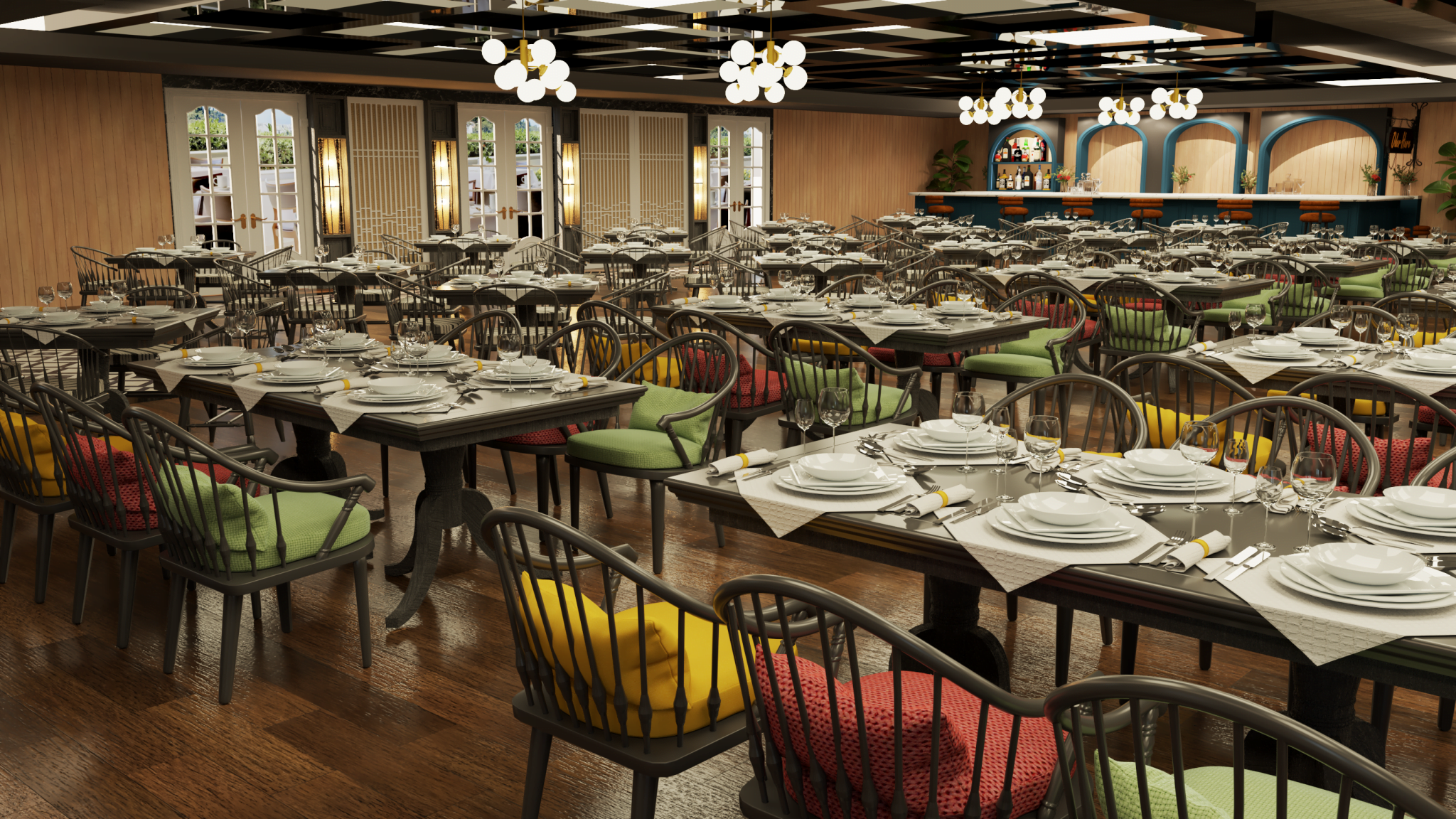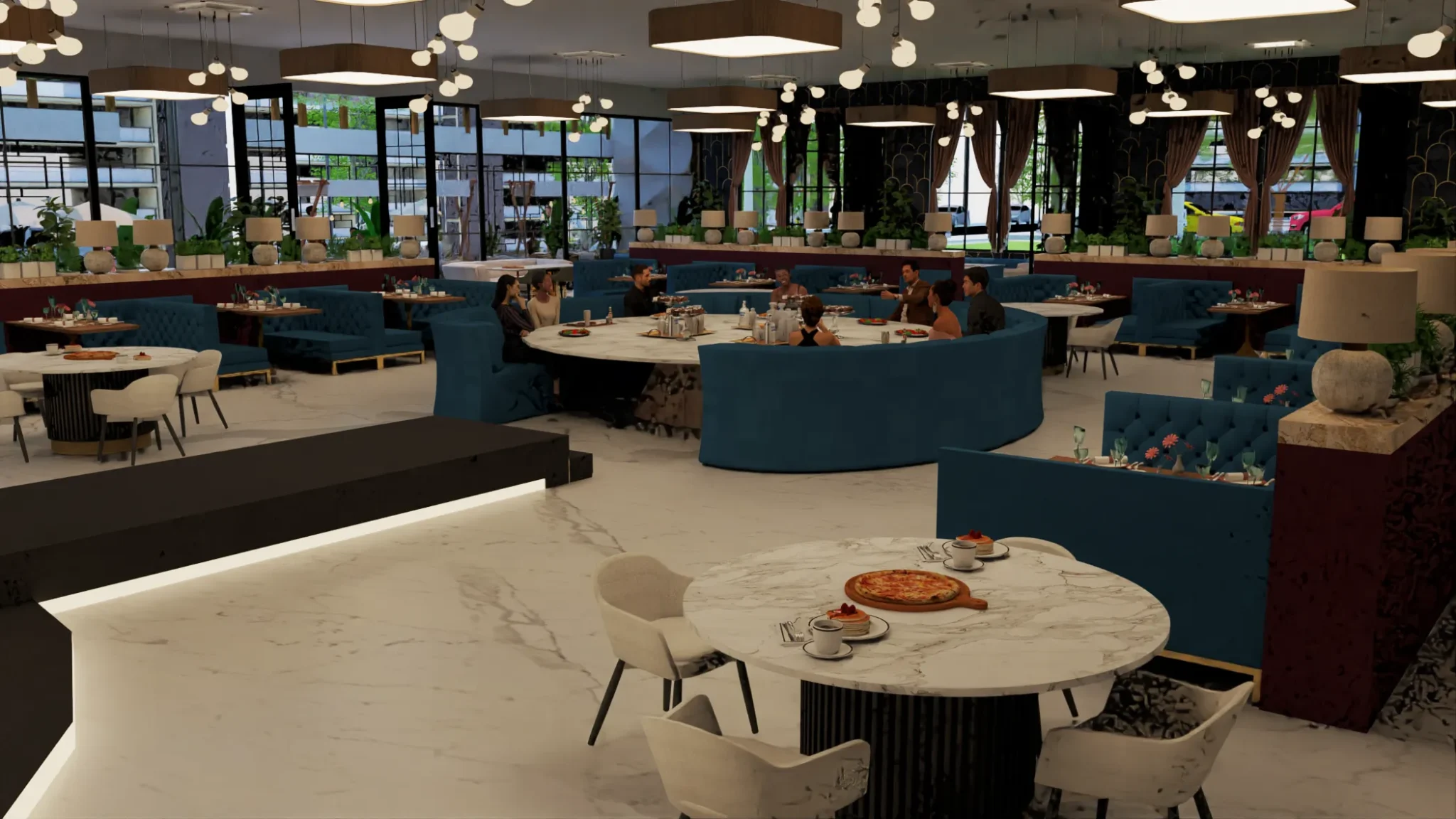Nowadays, social media is everything. Uploading pictures, videos and sharing new experiences. Modern life is all about cameras! By this, you can understand the importance of restaurant interior design. More than 50% of people select restaurants on the basis of how they look more than food.
If we talk about the UAE, statistics show out of 26,795 restaurants and cafes, only 2,516 restaurants are highly visited. So, what do you think this is only food that will be the reason? Clearly no; restaurant interior design is a big reason.
In this blog, we’ll talk about how to make your restaurant interior design luxurious in 2025 and get more customers.
Changing restaurant interiors in United Arab Emirates: possibilities and challenges
A worldwide center for luxury, the UAE combines modern innovation with a deep cultural legacy. But maintaining the fast-shifting tastes of consumers presents a major difficulty with this ongoing development. A few years ago, what was thought of as “luxury” might seem antiquated now; so, restaurant owners must change to remain competitive. For residents, who have their own unique cultural expectations, a design style that appeals to foreign clients might not be as significant.
Since the UAE is a melting pot of cultures, restaurant operators need to be aware of the cultural subtleties defining the eating experience here in addition to the luxury trends developing. While it can be challenging to balance these various consumer expectations with UAE heritage, it also offers an interesting chance to produce something original that appeals to residents as well as visitors.
The answer is: Keeping Ahead with Novel Design Trends
Innovation is the way to keep ahead in this very competitive business. While still honoring local culture and history, restaurant owners have to be aware of the newest worldwide design trends—from simple aesthetics to extravagant materials to future technologies. Working with well-known designers that understand modern design as well as cultural sensitivity will help produce a space that seems modern yet anchored in history. Maintaining long-term success depends mostly on research, imagination, and ongoing customer behavior adaptation.
Value of First impressions: designing that impact mind
First impressions define luxury dining. Guests entering a restaurant should feel as though they are stepping into an opulent world right away. Here is where internal design’s influence is most evident. A great design may enthrall visitors and define their whole dining experience. Making that immediate influence is not without difficulty, though. How do you produce something very remarkable while still allowing a broad audience to access it?
Important Points:
The first impression and entrance of a restaurant are rather important.
Juggling accessibility with luxury.
creating a design first impression that will last.
Solution: Strong Design Statements with Lasting Impact
A great entrance marks only the start. Dramatic lighting, art exhibits, and unusual seating configurations that grab attention let restaurant operators make a strong impression. From floor-to-ceiling windows to striking chandeliers, the design components should be a visual feast that thrills visitors. Combining modern technology with natural elements like water features and indoor plants will improve the mood and help the area to feel both opulent and friendly.
Sustainable Luxury: Trends in Eco-conscious Design Towards 2025
Sustainability is no longer only a trend as environmental issues keep growing worldwide; it is a need. But without compromising the upscale experience their patrons demand, how can luxury restaurants include sustainability into their designs? For restaurant operators, the increasing need for environmentally friendly design in upscale settings offers a special difficulty.
The answer is Combining Ecological Materials and Methods
Including sustainable fabrics, bamboo, and repurposed wood into the design helps one to reach this. High-end restaurants are also implementing energy-efficient architecture and smart technologies for waste management, lighting, and climate control. Working with local artists to incorporate locally produced, sustainable décor—which not only lessens the environmental impact but also reflects UAE sustainability—is another creative way.
Integration of Smart Technology: Improving Luxurious Comfort
Our daily lives today revolve around technology, and more luxury restaurant interiors are including it. The difficulty, though, is gently incorporating modern technology into a design without sacrificing the look. How may restaurant operators use technology to improve the dining experience without it being inappropriate or overly invasive?
The answer is seamless smart technology for a luxurious dining experience.
Start with smart lighting, automated seating, and customized music systems. Modern touches from interactive tables and digital menus improve the whole eating experience. Furthermore, improving the visitor experience without sacrificing the luxury ambiance are smart glass that changes transparency for privacy, temperature management systems that generate ideal comfort, and AI-driven experiences that fit personal preferences.
Cultural Sensitivity: Combining contemporary luxury with age-old components
In a culturally rich area like the United Arab Emirates, modern luxury and reverence of history always coexist in a delicate equilibrium. Though modern design aesthetics are crucial, they should be carefully combined with regional customs and cultural inspirations. How do proprietors of restaurants negotiate this careful equilibrium?
Solution: Including regional design elements and authentic Emirati components
Weaving classic design features into the space in a manner that feels modern and opulent is a good strategy. Arabic calligraphy, classic geometric designs, or local artwork reflecting the UAE’s rich past might all be included. While keeping cultural sensitivity, using extravagant materials like marble, gold, and crystal helps produce a polished environment that seems both sumptuous and authentically culturally relevant.
Building Multi-Sensory Experiences by Encouragement of Emotional Connections
Luxurious eating is about connecting visitors emotionally by using all five senses, not only appearances. How can restaurant operators create environments that evoke strong emotional effects and appeal to more than just the sight?
How Multi-sensory design elements will help to improve the dining experience.
Multi-sensory design is becoming a prominent trend, from well-selected scents that convey luxury to soundscapes that improve the environment. An immersive experience is created via aromatherapy, relaxing background music, tactile materials, and visually arresting accents. Restaurants may improve the whole experience by including sight, smell, touch, sound, and even taste, so ensuring that their customers will remember them.
Special and Customized Dining Areas: Serving the Elite
When serving wealthy clients, secrecy and uniqueness take front stage. Although there is an increasing need for customized, private dining experiences, how can businesses create environments that not only provide intimacy but also reflect the luxury their high-end customerele deserves?
Designing for Exclusivity and Privacy in Luxury Spaces
Luxury restaurants are providing private dining rooms with custom furnishings, soundproofing, and distinctive layouts with tailored elements more and more. While personalized elements like tailored dinnerware and handmade décor make every dining experience unique, high-end materials like velvet, marble, and crystal enhance the ambiance. This degree of exclusiveness lets visitors feel unique while still enjoying the conveniences of a luxury environment.
Lighting as a Design tool: The Function of Light in Establishing Environment
Though in luxury dining it must be done exactly properly, lighting can totally change the atmosphere of a venue. How may restaurant operators improve the ambiance with lighting without overloading the area?
Lighting Design: Complementing Interior and Mood Enhancement
The attitude of the restaurant depends much on the lighting. Using layered lighting—task, ambient, and accent—restaurant owners may create a customizable environment that fits the time of day or intended mood. While smart lighting systems can change to fit consumer tastes and improve the whole dining experience, statement chandeliers and premium fixtures provide a little of luxury.
Art and Custom Design Element Enhancement of Aesthetic Appeal
In interior design, art may be a great tool; nevertheless, choosing the correct pieces to accentuate the brand and look of the restaurant is no easy chore. How can proprietors of restaurants make sure their artwork accentuates the area without overpowering it?
Answer: Choosing artistic components to improve the brand identification and space.
Custom-built furniture pieces, sculptures, and bespoke art installations can serve to communicate the restaurant’s values and improve the luxury experience. Working with well-known artists or including regional or cultural inspirations into the design lends a distinctive, individual touch. A luxury restaurant’s ambiance must thus include art since it can also arouse particular feelings and provide a storytelling experience for visitors.
At Last,
Finally, luxury restaurant interior design in the United Arab Emirates is always changing under new trends and problems influencing the dining experience. Creating remarkable dining environments requires careful balancing innovation with cultural sensitivity, sustainability with luxury, and personalizing with exclusivity. Maintaining a competitive edge in a market always shifting depends on restaurant owners being flexible and forward-looking. Keeping an eye on current trends and embracing fresh design possibilities will help them create environments that not only look great but also offer their visitors an outstanding experience.
When planning a luxurious restaurant space in the UAE, it’s essential to stay updated on the latest trends and timeless design principles. For a deeper dive into what’s shaping the industry, explore these 12 stunning restaurant interior design trends in Dubai and get inspired by our top restaurant interior design ideas for luxurious dining. These resources complement our current guide by showcasing innovative concepts, material choices, and styling tips that can elevate any restaurant’s ambiance.
When crafting luxury restaurant interiors in the UAE, it’s essential to blend cultural aesthetics with modern elegance. From lighting and layout to furniture and materials, every element should reflect the brand’s personality and the region’s taste for refinement. Partnering with an experienced interior designing company ensures that each detail is thoughtfully executed, creating a dining experience that’s both memorable and visually stunning.
Frequently asked questions
1. In what way do UAE luxury restaurant interiors capture local culture? To honor local culture and provide a refined experience, luxury restaurants in the UAE mix modern design with traditional features including Arabic calligraphy, geometric designs, and locally produced materials.
2. In what part does technology influence the décor of luxury restaurants? By providing automatic lighting, seating, and customized services that fit the design of the restaurant without upsetting the luxury environment, smart technology improves the client experience.
3. How can eateries strike a mix between luxury demands and sustainability? Luxury restaurants may uphold their high standards and lower their environmental effect at the same time by choosing sustainable practices, energy-efficient designs, and environmentally friendly products.
4. Why is the interior design of a premium restaurant noteworthy? The inside of a luxury restaurant should make an instant visual impression with its combination of dramatic lighting, strong design elements, and distinctive objects engaging patrons and improving the whole dining experience.


